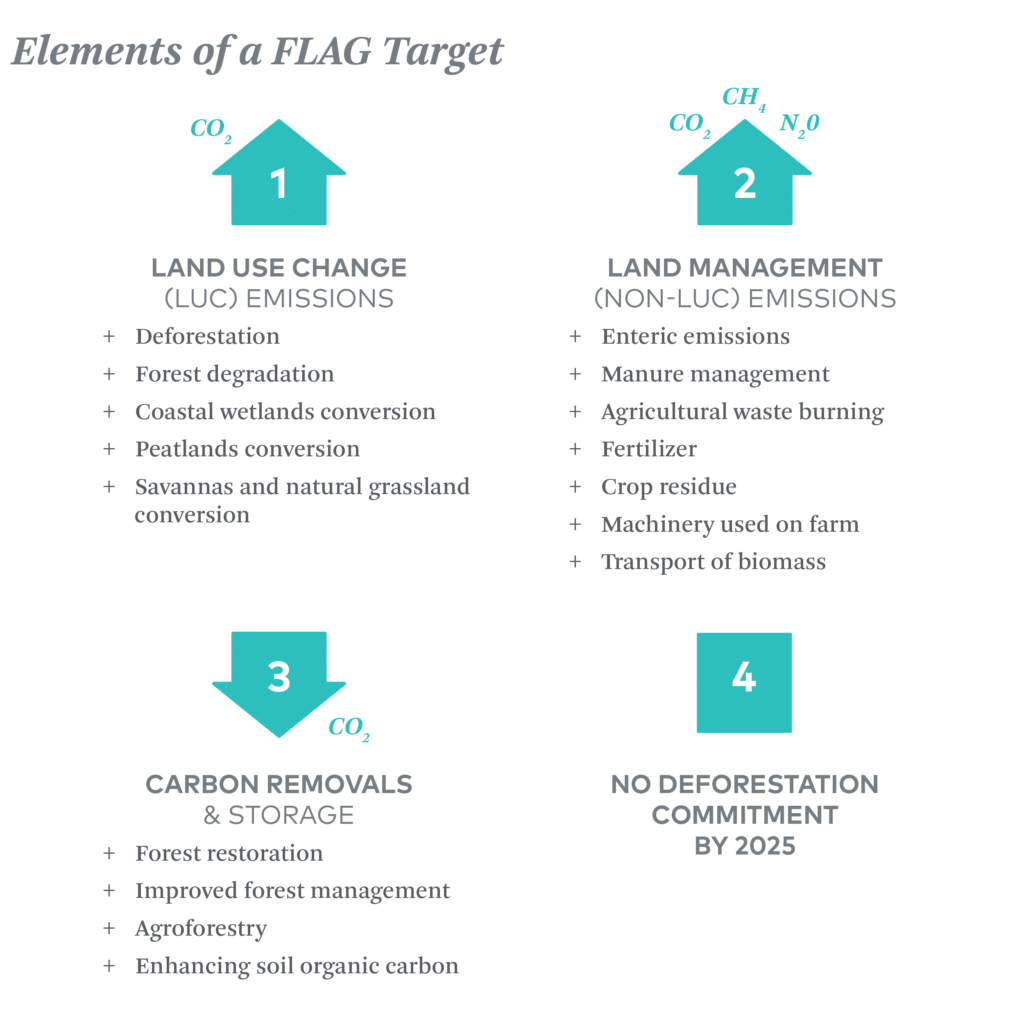The land sector could contribute up to 37% of all emissions reductions and removals needed through 2030. To accelerate that mitigation and stimulate climate action in the private sector, the Science Based Target initiative (SBTi) released guidance for how corporations that have Forest Land and Agriculture (FLAG) designated sectors in their value chain can reduce associated emissions. Published in late 2022 and updated in December 2023, SBTi’s FLAG requirements stipulate a reduction of emissions associated with the land sector (also referred to as agriculture, forestry and other land use (AFOLU) sectors).
Historically, it has been difficult to evaluate the source of emissions with greenhouse gas (GHG) accounting and other standard target setting approaches. And prior to releasing its recent FLAG guidance, SBTi did not require FLAG emissions be included in target setting. This rule aims to close that gap in land-based emissions, ensuring these emissions sources are included in science-based target (SBT) setting.
There are many pieces of criteria necessary for a FLAG target to get validated, and it can be challenging to make sure each step is completed correctly. To help you prepare successful FLAG targets, we will look at key criteria of FLAG SBTs and how they are different from other targets, as well as the common challenges and solutions that compliance companies may face in addressing their FLAG emissions.
Who is impacted?
 20% FLAG emissions.” width=”860″ height=”572″>
20% FLAG emissions.” width=”860″ height=”572″>
Before getting underway, it is prudent to step through the FLAG requirements to determine if your organisation stands to be affected and if a FLAG target is relevant to your company. All organisations that are involved in SBTi will have to quantify their FLAG emissions, but it also boils down to the sectors your operational activities are related to and what percentage of your emissions fall under the FLAG sector umbrella.
SBTi stipulates that companies with FLAG-designated sectors (i.e., forest and paper products (forestry, timber, pulp and paper, rubber), food / agricultural production, animal source, food and beverage processing, food and staples retailing, and tobacco) in their value chain must set a FLAG target (unless FLAG emissions represent less than 5%). A company with an approved SBTi target or a company setting its first SBTi target must set a FLAG target if their land-related emissions account for more than 20% of their total emissions across scopes 1, 2, and 3. Industries that could potentially be affected include retail, packaging, tourism and hotels, textiles / fashion, and building products.
Companies that are part of FLAG designated sectors and fall below SBTi’s 5% threshold and companies that are not part of FLAG-designated sectors and fall below SBTi’s 20% threshold can choose whether to set a FLAG target (which is recommended), but they must quantify their FLAG emissions and, if not setting a separate FLAG target, then include them in their non-FLAG target, also called energy and industry targets.
What is the flag target?
Before we get into the common challenges and solutions of FLAG SBT setting, let’s first define the key criteria of FLAG targets and outline how these targets differ from non-FLAG targets. A FLAG target is a SBT that applies to a company’s GHG emissions from AFOLU practices and consists of four key focus areas – land use change, land management, carbon removals and storage, and zero deforestation. FLAG SBTs are in addition to and separate from energy and industry SBTs, or non-FLAG targets, due to their specific coverage of land sector related emissions, but also due to very different decarbonisation potential.  Since FLAG SBTs are separate from non-FLAG SBTs, FLAG abatement cannot be used to meet energy and industry targets (e.g., improved forest management removals cannot be used to meet targets on fossil fuel emissions reductions), and biogenic removals must be accounted for only to meet FLAG targets.SBTi provides guidance for both near- and long-term FLAG targets, and provides two approaches to target setting – the FLAG sector pathway or FLAG commodity pathways for 11 key FLAG commodities (i.e., beef, dairy, leather, rice, timber, etc.). For near-term targets, SBTi states that target dates should be set for 5 to 10 years after the submission date, and for long-term targets, the date should be set for 2050 or earlier. Aligned to the 1.5 degree scenario, companies should strive towards meeting near-term goals with the ambition of reducing about 2.5%-4% of their FLAG emissions each year depending on the FLAG target pathway relevant to the target setter.
Since FLAG SBTs are separate from non-FLAG SBTs, FLAG abatement cannot be used to meet energy and industry targets (e.g., improved forest management removals cannot be used to meet targets on fossil fuel emissions reductions), and biogenic removals must be accounted for only to meet FLAG targets.SBTi provides guidance for both near- and long-term FLAG targets, and provides two approaches to target setting – the FLAG sector pathway or FLAG commodity pathways for 11 key FLAG commodities (i.e., beef, dairy, leather, rice, timber, etc.). For near-term targets, SBTi states that target dates should be set for 5 to 10 years after the submission date, and for long-term targets, the date should be set for 2050 or earlier. Aligned to the 1.5 degree scenario, companies should strive towards meeting near-term goals with the ambition of reducing about 2.5%-4% of their FLAG emissions each year depending on the FLAG target pathway relevant to the target setter.
The FLAG target setting process is challenging and there are many nuances. SBTi excludes carbon credits, avoided emissions, product carbon storage, technological removals, and bioenergy as methods to account for FLAG emissions.
SBTi sees the potential for increased carbon removals, and expects that committed companies deliver both emissions reductions and land-based removals. Companies can engage with biogenic carbon removals by employing agroforestry, restoring natural ecosystems, deploying silvopasture, improving forest management practices, and enhancing soil carbon sequestration. Carbon removals included in FLAG targets must be traceable, include primary data, lead to an increase in net land carbon stock, show long term storage of carbon, and take place on land owned or operated by the company (or, within their value chain).
Removals are reported separately from emissions in your inventory and are counted against your FLAG emissions. Companies are encouraged to follow specific GHG Protocol (GHGP) Land Sector and Removals guidance, which requires similar methodology to what is found in offsetting projects (in this case, it would be insetting), and the percentage of carbon reduction over time is crucial. The final FLAG SBT criteria is to have a public, net zero deforestation commitment. 
How should I prepare?
For FLAG targets, companies should first identify and include all land-related emissions in their GHG inventory, following GHGP Guidance. If your organisation stands to be impacted by the FLAG rule, there are many ways to get ready and ensure that your target becomes validated. First, companies can begin learning about no deforestation commitments and taking prescribed steps that allow for an end to deforestation by 2030. Companies may also start understanding their supply chain and its connection to deforestation. A key strategy is data collection on biogenic commodities in the supply chain (or, data on any environmental attributes these commodities might have). Another important component to FLAG preparation is engagement with suppliers and understanding key FLAG-related suppliers. Lastly, companies should explore the eligible FLAG sector removal projects that exist within their value chain.
What are the expected challenges?
SBTi’s FLAG guidance has been active for about a year now, and as of January 2024, just over 20 companies have received validation for their FLAG targets. FLAG emissions reporting and reduction is still a new space, and there are factors that are important to consider before getting started. From our experience, a common barrier to FLAG target setting is that most FLAG emissions are in scope 3, thus meaning limited available data and influence. Another challenge is that many companies still use spend data for part of their scope 3 emissions, while more granularity is required in order to quantify FLAG emissions.
There also isn’t clarity around how to set boundaries and what emission sources are covered, as the GHGP for Land Sector and Removals Guidance is still in draft format. There are no databases available that directly address FLAG emissions. Much of the FLAG-related data was not historically collected and thus needs to be integrated into the data collection process and supplier communication (i.e., data on no deforestation and land use practices).
Next steps
Companies with operations and activities that touch AFOLU sectors are in a unique position to reduce a major source of emissions and advance collective movement towards a net zero economy. We are encouraging our clients to begin the process of FLAG emissions accounting and prepare for target setting now, with a focus on accurate data and value chain engagement. It is important to remember to establish the right boundaries (what are FLAG emissions and non-FLAG emissions?), and focus on hotspots and commodities with higher FLAG emissions. A final tip is that your company can use life cycle analysis (LCA) data to quantify what proportion of FLAG emissions are in your inventory.
3Degrees closely follows the evolution and changes to both GHGP and SBTi guidance, and posts regular updates on the latest FLAG-related requirements. Check back with us to stay up-to-date, or get in touch today for additional target-setting expertise.

